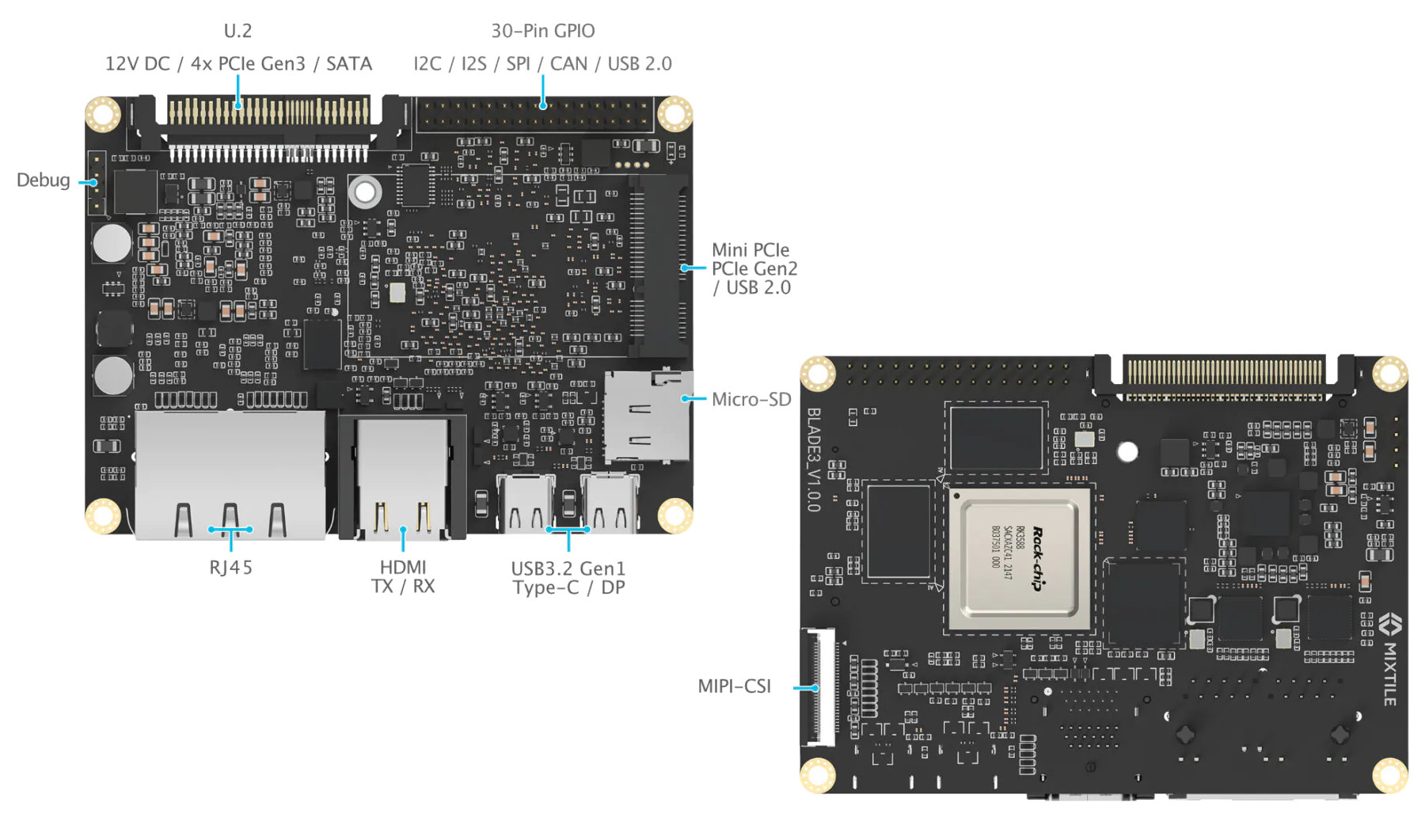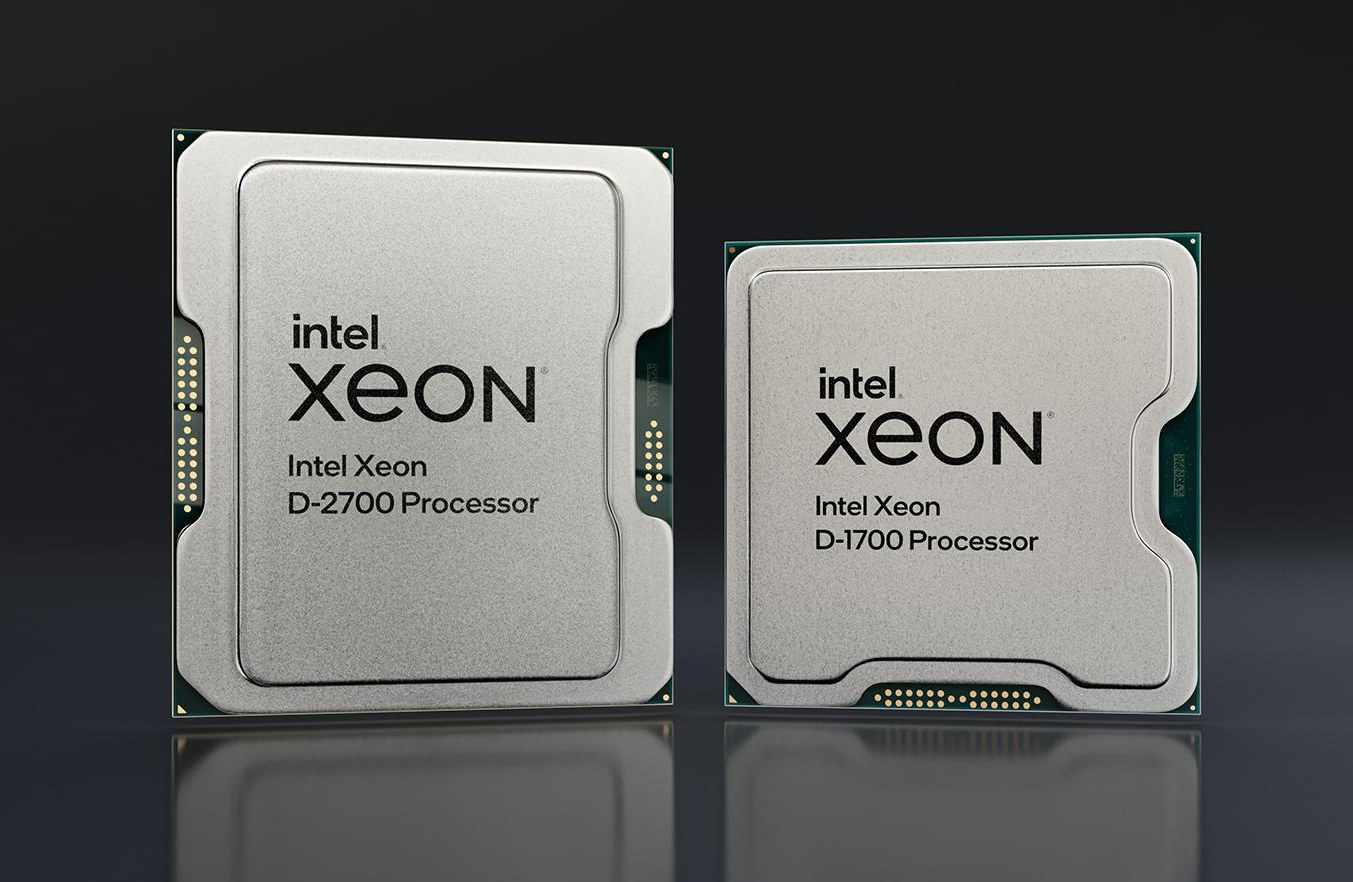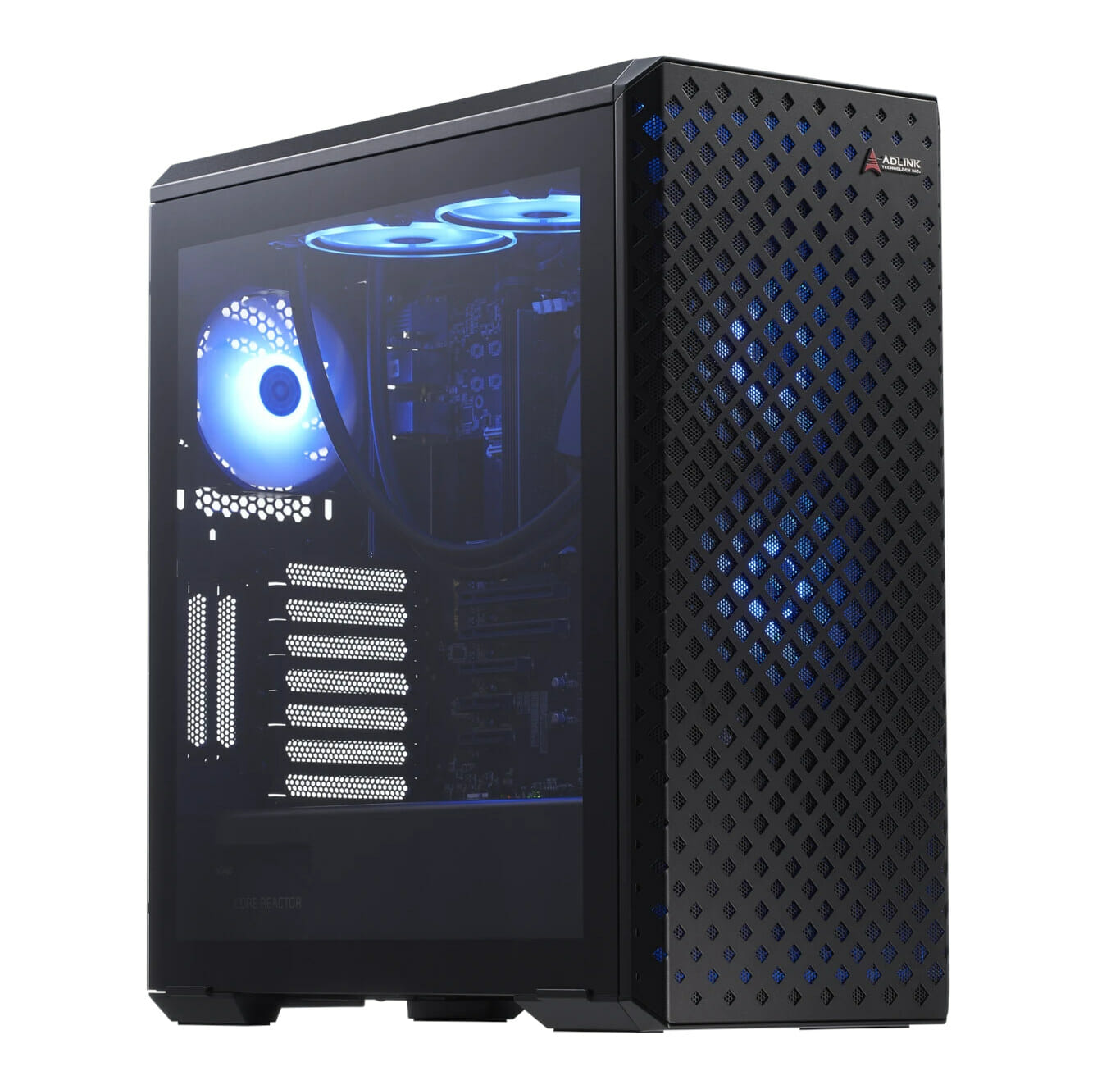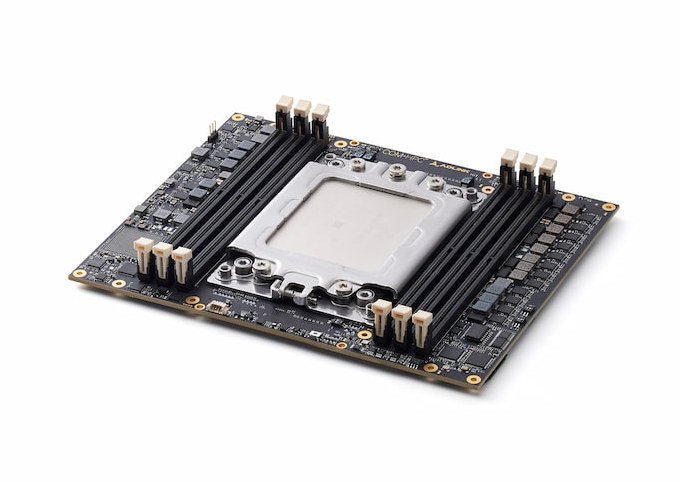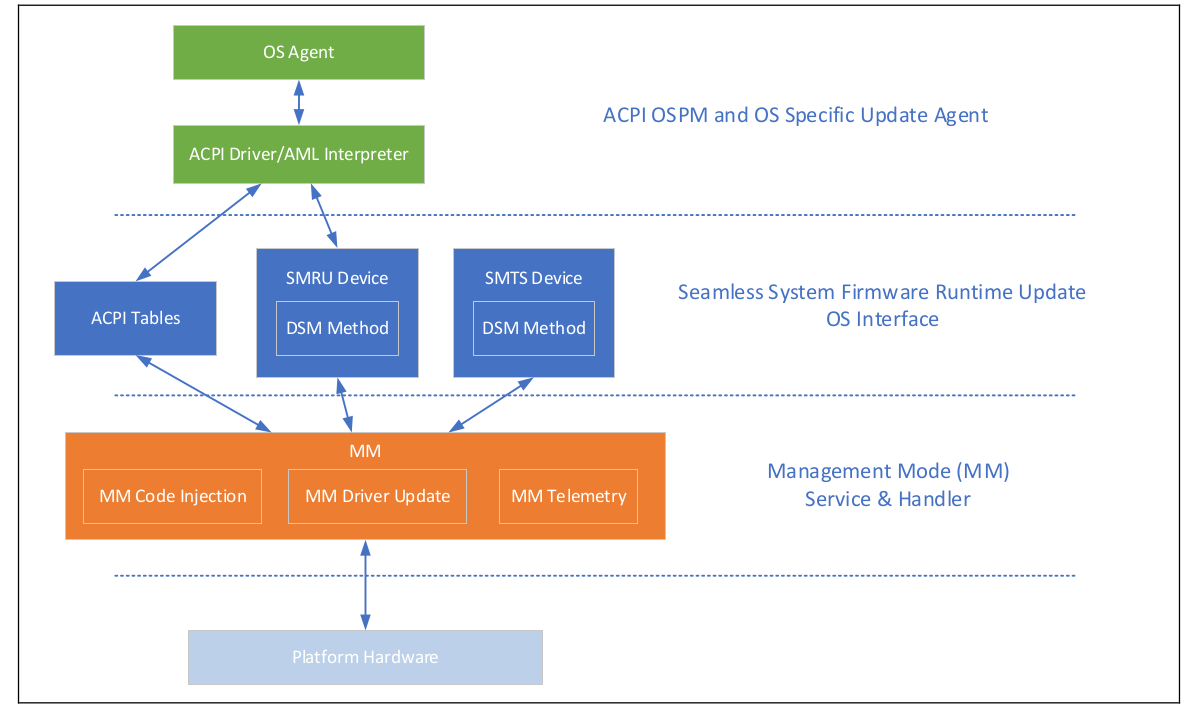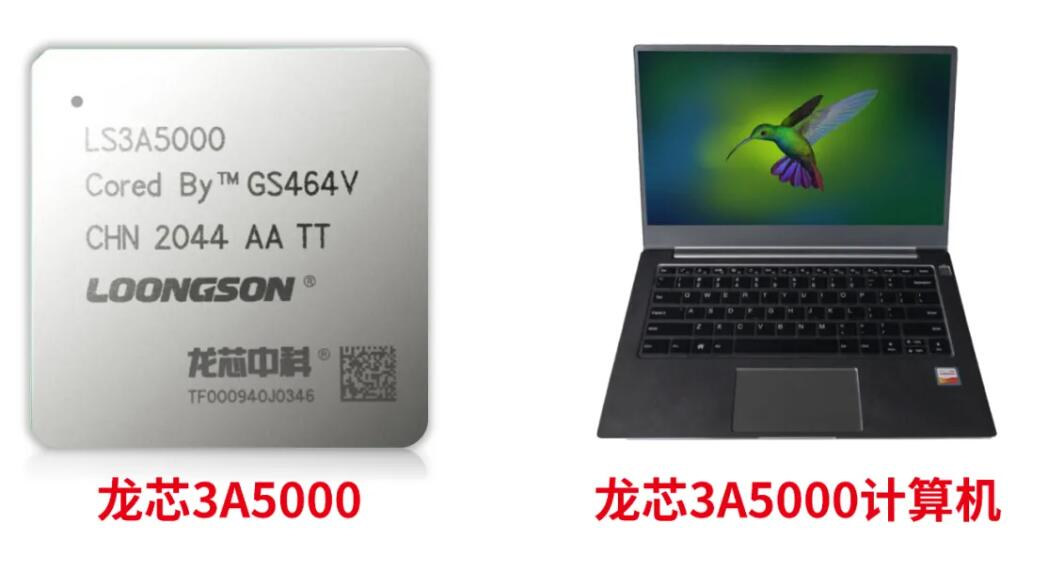ADLINK has just announced the availability of the Arm SystemReady SR-certified Ampere Altra Developer Platform equipped with the company’s COM-HPC Ampere Altra module with 32 to 80 64-bit Arm Neoverse N1 cores, 32GB to 128GB RAM. An adaptation to the earlier AVA Developer Platform expected to sell for $5,450, the Ampere Altra Developer Platform got a price cut to $3,999 at launch for a system with a 32-core processor, and 32GB DDR4. The system targets software developers wanting to build cloud-to-edge applications using standardized Arm hardware. Ampere Altra Developer Platform specifications: SoM – COM-HPC Ampere Altra module with Ampere Altra 32 to 80-core 64-bit Arm Neoverse N1 processor up to 1.7/2.2/2.6 GHz (32/64/80 cores, TPD: 60W to 175W), 32 GB to 128GB DDR4 ECC memory Storage – 128 GB NVMe M.2 SSD Mainboard – COM-HPC Server Base carrier board Video – VGA port Audio – 3.5mm audio jack Networking 1x […]
Mixtile Blade 3 – A Rockchip RK3588 Pico-ITX board for server applications
The Rockchip RK3588 hype continues with the Mixtile Blade 3, a new Pico-ITX board powered by the Cortex A76/A55 processor, coupled with up to 32GB RAM, up to 256GB storage, and designed for server applications with two 2.5GbE interfaces. The single board computer also comes with HDMI 2.1 output, HDMI 2.0 input, USB 3.2 Gen 1 USB Type-C ports, a mini PCIe Gen 2 for expansion, and a PCIe Gen 3 x4 connector to connect two Mixtile Blade 3 boards together for high-performance computing. Mixtile Blade 3 specifications: SoC – Rockchip RK3588 octa-core processor with four Arm Cortex-A76 cores @ up to 2.4 GHz, four Arm Cortex-A55 cores, ArmMali-G610 MP4 quad-core GPU with support for OpenGL ES3.2, OpenCL 2.2, Vulkan1.1, 6 TOPS NPU, 48MP ISP, 8Kp60 video decoding, 8Kp30 video encoding System Memory – Up to 32GB LPDDR4 memory Storage – Up to 256GB eMMC flash, MicroSD 3.0 card socket, […]
Intel Xeon D network and edge processors find their way into COM Express & COM-HPC modules
Intel has recently launched the Intel Xeon D (Ice Lake-D) processor family with the D-2700 and the D-1700 models designed for software-defined network and edge applications with integrated AI and crypto acceleration, built-in Ethernet, support for Intel Time Coordinated Computing (TCC) and Time-Sensitive Networking (TSN), plus high reliability. The new processors are bringing data center-class hardware to the edge, and at least two embedded systems companies, namely ADLINK Technology and Congatec, have already launched COM-HPC server modules and COM Express Type 7 module based on the new Intel Xeon D family. Intel Xeon D processors Intel Xeon D-2700 and Intel Xeon D-1700 are designed for space- and power-constrained ruggedized environments, feature industrial-class reliability, hardware-based security, and up to 56 high-speed PCIe lanes to support networks with up to 100Gbps Ethernet. While the Intel Xeon D-1700 sub-family is scalable from 2 to 10 cores, the Intel Xeon D-2700 family goes up […]
Octo4a app installs OctoPrint server on Android smartphones
Octoprint is a popular open-source 3D printer controller software that runs on Raspberry Pi boards, Orange Pi Lite SBC, Amlogic TV boxes, and other devices. But considering many people may already an older, perfectly working smartphones at home, FeelFree (Filip) decided to create the Octo4a project that install an Octoprint server on Android smartphones. It makes perfect sense since many smartphones come with a USB OTG interface that can connect to the 3D printer for control, while the touchscreen display is used for the user interface, and the camera to monitor your prints. SSH could be used to access the phone Octoprint server and change the settings manually. You can access the source code and APK files on Github. You’ll need to enable third-party apps in the settings before installing the app in order to install Octoprint on the phone. The only required permission is storage, except if you’d like […]
AVA Developer Platform offers 32 64-bit Arm cores, 32GB RAM, 10GbE for $5,450
The AVA Developer Platform was announced together with ADLink COM-HPC Ampera Altra server module for embedded applications with up to 80 64-bit Arm cores, up to 768GB DDR4, 4x 10GbE, and 64x PCIe Gen4 lanes. The AVA Developer Platform is not fitted with the top-end COM-HPC module, but still, with a 32-core COM-HPC Ampere Altra module fitted with 32 GB DDR4 memory, plus a 128 GB NVMe M.2 SSD, and an Intel Quad X710 10GbE LAN card, it still makes an impressive workstation for native Arm development. We did not know the price the last time, but now we do as the workstation is available for pre-order for $5,450. AVA Developer Platform specifications: SoM – COM-HPC Ampere Altra module with Ampere Altra 32-core 64-bit Arm Neoverse N1 processor up to 3.3 GHz (TPD: 60W), 32 GB DDR4 memory Storage – 128 GB NVMe M.2 SSD (From photos see below: extra […]
ADLINK COM-HPC Ampere Altra 80-core Arm server module targets embedded applications
ADLINK has integrated Ampere Altra, an up to 80-core Armv8.2 server processor with up to 175W TDP, into a COM-HPC module designed for embedded applications, together with the AVA Developer Platform equipped with a 32-core processor and housed in an “ultra-silent liquid-cooled tower system”. Both the ADLINK COM-HPC Ampere Altra module and the developer kit are compliant with the just-announced Arm’s Scalable Open Architecture for Embedded Edge (SOAFEE), a “software initiative and reference implementation providing a cloud-native environment for embedded edge development”. ADLINK COM-HPC Ampere Altra COM-HPC Ampere Altra key features and specifications: SoC – Ampere Altra with 32x to 80x Armv8.2 Neoverse N1-based cores with up to 3.3 GHz frequency, up to 128 lanes of high-speed PCIe Gen4 and 8×72 ECC protected DDR4 3200 memory; TDP: 60 to 175 Watts depending on the number of cores System Memory – Up to 768GB DDR4 with 6x individual memory channels Networking […]
Intel Seamless Update to enable BIOS/UEFI firmware updates without a reboot
Updating the BIOS/UEFI binary usually requires a reboot, but Intel is working on changing that, at least on Linux servers for now, with the Intel Seamless Update aiming to carry out system firmware updates (e.g. UEFI) at run-time without having to reboot, a bit like what Canonical does with the Ubuntu Livepatch service, but at a lower level in the software stack. Intel submitted a patch that “Introduces Platform Firmware Runtime Update and Telemetry drivers” to the Linux kernel mailing list a couple of days ago with the description reading in part: High Service Level Agreements (SLAs) requires that the system runs without service interruptions. Generally, system firmware provides runtime services such as RAS (Reliability, Availability and Serviceability) features, UEFI runtime services and ACPI services. Currently if there is any firmware code changes in these code area, the system firmware update and reboot is required. Example of bug fix could […]
Loongson’s first LoongArch processors – 3A5000 for computers, 3C5000L for servers
Loongson has officially launched the first processors based on LoongArch CPU instruction set architecture designed for made-in-China SoCs without the need to license technology made outside of China. Loongsoon LS3C5000L (3C5000L) 16-core server processor clocked at up to 2.5 GHz is now official and is apparently comprised of four LS3A5000 (3A5000) LoongArch processors designed for desktop computers and laptops. Loongson 3A5000 CnTechPost reports Loongson 3A5000 quad-core 64-bit GS464V processor runs at 2.3GHz-2.5GHz. GS464V microarchitecture comes with four fixed-point units, two 256-bit vector operations units, and two access memory units. The processor also includes two 64-bit DDR4-3200 controllers with ECC checksum support, as well as four HyperTransport 3.0 controllers with multi-processor data consistency support. Performance-wise, Loongson 3A5000 is said to achieve 26+ points in the single-core and floating-point SPEC CPU2006 benchmarks, and over 80 in the multi-core version of the benchmarks. That’s about 50 percent higher performance than the previous pin-compatible […]



